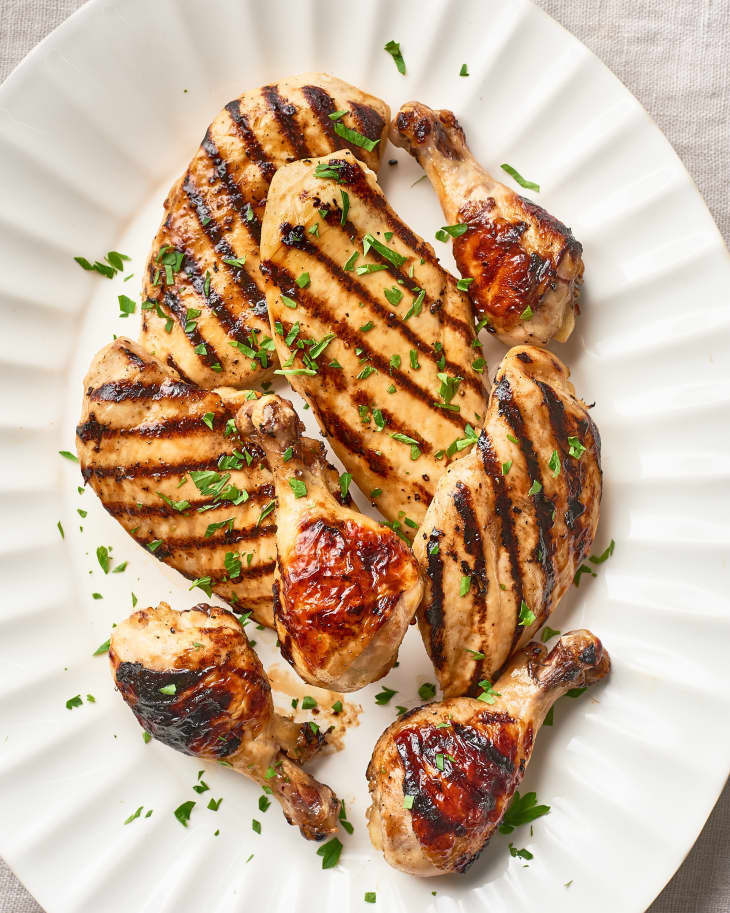10 Tips for Perfect Grilled Chicken
Grilled chicken is a rite of passage for summer cooking; it works for both a big barbecue blowout and a simple weeknight dinner. While you can just slap some pieces onto the grill, there are a few tips to keep in mind that will yield perfectly grilled chicken every time!
1. Pick the right cut of chicken.
The first thing to think about when grilling chicken is which cut to pick. Do you have a lot of time to kick back and grill, or is this a fast weeknight dinner that has to happen in 30 minutes? Remember that the larger the cut of chicken (whole birds, bone-in chicken breasts, whole legs), the longer it will take to cook. Stick with boneless or even consider cutting boneless chicken into small pieces and threading it onto skewers if the cooking needs to happen quickly.
2. Pound boneless, skinless chicken breasts first.
The uneven shape of boneless, skinless chicken breasts makes them tricky to grill, but by just spending a few minutes pounding the thicker end thinner, you’ll both reduce cooking time and end up with more evenly cooked meat.
3. Butterfly whole chickens.
Grilling whole chickens is certainly impressive and great if you want to appease both white- and dark-meat eaters, but whole chickens do take a long time to cook, and it takes some practice to carve one up nicely. Butterfly a whole chicken instead (also known as spatchcocking), which means cutting out the backbone so the chicken now lies flat. Not only does this speed up grilling time, but the chicken also cooks more evenly and is easier to carve.
Read more:
4. Add flavor before you grill.
The best part of grilling is the ritual of throwing it onto the grill and relaxing with a drink while it cooks. Take a little extra time to inject flavor into the chicken before grilling so you can skip basting and don’t have to do much work as it grills, and you know the end flavor will be amazing. Try a brine, rub, or marinade — it doesn’t have to be fancy at all!
5. Prep your grill properly.
Like any other kitchen appliance, a grill needs to be maintained, cleaned, and prepped to work properly and efficiently. If you want great grilled chicken, make sure you have enough fuel, and rub a little oil onto the (clean and preheated) grates right before cooking so the chicken doesn’t stick.
6. Stay away from high heat.
Chicken is not steak or burgers, where you want a fairly high heat to get a good sear on the outside. Since chicken needs to cook thoroughly but you don’t want the skin to burn, it’s wise to cook it over medium, indirect heat for most of the cooking time. For a charcoal grill, this may mean building a two-level fire or only having coals on half of the grill, and for a gas grill, a medium heat works best.
7. Cover the grill.
One of the biggest mistakes I see with novice grillers is that they don’t cover food as it’s grilling. You not only lose a lot of heat with an uncovered grill and waste fuel, but food just takes longer to cook. A covered grill creates a sealed, oven-like environment that surrounds your food on all sides, which is especially important when you’re trying to thoroughly cook chicken. If your grill doesn’t happen to have a lid, an upside-down disposable foil pan can do the trick.
8. Avoid cross-contamination.
When handling raw chicken, it’s important to be very careful to avoid cross-contamination. Once the raw chicken is on the grill, thoroughly wash anything it touched (especially your hands) in hot, soapy water. Never (ever!) just wipe off the platter you took the chicken out to the grill with and put the cooked chicken back on it!
When brushing chicken with sauce, reserve some of the sauce for serving and place it in a separate bowl. Brush the chicken with the rest of the sauce, and if you have some brushing sauce left after the chicken’s cooked, bring it to a full boil before serving it.
9. Sauce or baste often and at the end.
I love how sauce glazes chicken and caramelizes onto it, but you don’t need to brush the sauce on until the end because it can burn. Start basting about 15 minutes before the chicken is done, and baste all over, turning the chicken a few times, so that each layer has time to cook and stick to the chicken.
10. Use a thermometer.
Finally, chicken needs to be cooked to a safe temperature of 165°F, so you should use a meat or instant-read thermometer to check that the chicken is done. Insert it into the thickest part of the thickest piece, and just be careful the tip of thermometer isn’t touching bone, which can give you a false reading.
If you forgot or don’t have a thermometer, don’t be afraid to cut into a thick piece to make sure the juices run clear and that the meat is no longer translucent but opaque.
Grilled Chicken Recipes
Updated from post originally published July 1, 2015.
